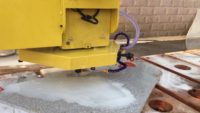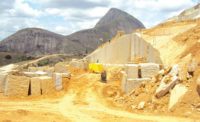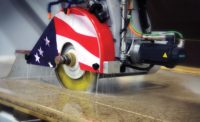Michael Roesner, the manager of technical services for GranQuartz, originally started as a fabricator and for the past five years has moved into his position with GranQuartz.
For those that don’t know pre-setting, Rosener explains it as, there is tooling to create different edges in the fabrication shop from a CNC machine, the pre-setting machine measures those tools so fabricators can get accurate Z values, diamaters and radiuses, so you can run those tools on the CNC machine.
“Without a pre-setter, you’re basically taking the time on the machine to measure the tools and set the tools up properly so you get a great quality edge,” said Rosener. “The pre-setter actually takes the tool off the machine to get those values set up so you can give the machine time back to the shop so it can produce more efficiently.
“If you have a CNC machine and you’re running tooling on it you have to set up the tools when you initially get them, you have to maintain those tools by adjusting them for the wear and tear,” Rosener went onto say. “The pre-setting machine is doing all that stuff off the actual CNC machine.”
Pre-setting machines like the Zoller, a set of seven tools can be measured in about 15 minutes. Compared to a CNC machine you are looking at an hour or two hours.
For fabricators who may be worried if this sounds like too much, Rosener explains that common sense goes a long way and training is pretty simple with the machine.
“If you purchase a machine we come to your shop we spend at least three days with you setting up the machine, getting it calibrated to your CNC machine, getting everything set up and going through the training to measure the tools,” said Rosener. “After that initial set up and training we do offer remote support. So we could log into any machine remotely and run through a set of tools with the guys and answer any questions they may have, do a quick refresh. We do for a fee offer on-site training. So we can spend some time at the shop if needed.”
As far as a rough ROI for the pre-setter, that depends on the different shop. According to Rosener, a shop with four or five machines is going to get a ROI in less than six months no problem.
“A one-machine shop for an ROI, you’re looking at six months to a year,” said Rosener. “If you’re maintaining your tools properly you should be spending one to two hours a week, at least, tying up your machine time dressing up your tools and maintaining them. We figure one hour a week, is roughly $30,000 of production lost in a year. So if you are doing two hours a week, $60,000 is going to get made up in no time. That’s just machine time back on the Zoller. A lot of times we can turn up the feed rates because you are moving the smallest amount of material with these tools we can push it a bit faster.




